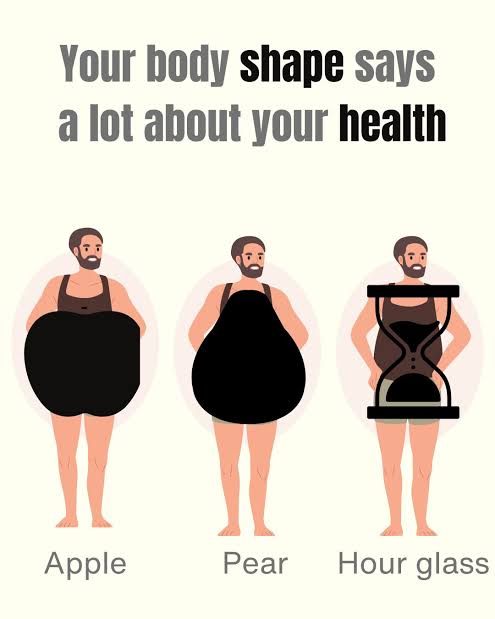People have long used fruit terms to describe their body shape. This is the easiest way to identify body types without using scientific terms that are not easy to remember. You have often heard the terms pear type body or apple type body. So what do these mean? Let’s take a look at this first, then examine the research on the health effects of body types.
What does apple or pear body type mean?
The apple body type is known in the scientific community as the android body, and it refers to the fact that the fat is stored more in the middle section, whereas in the hips and thighs there is less lubrication. In people with Android body type, the waist and hip ratio is almost the same.
In contrast, the pear body type is known as the jinoid and means that the fat is more in the hip part. In people with a Jinoid body type, the hips are wider compared to the waist.
The hourglass body type is considered ideal. In this body type, the shoulders and hips are symmetrical. At the same time a thin waist is also among the characteristics of the hourglass body type. As the name suggests, the body is similar to the hourglass shape.
What are the health effects of body types?
First of all, what type of body you have cannot give you clear data about your health. So those who have the apple body type are healthy, those with the pear body type can not talk with firm judgments in the form of unhealthy. However, various studies on the subject show that certain body types can be associated with some negative health consequences.
For example, in 2020, 72 research results were examined that the report concluded that people with (elma body type) more fat in the stomach area had a higher risk of death than people with pear-shaped bodies.
In 2019, 2,683 postmenopausal women participated inquire, women with apple body type were 3 times more likely to develop heart disease than women with pear body type. Interestingly, having a pear-type body seemed to have a protective effect against heart disease.
Here in the study, it was found that those with apple body type had more tendency to heart diseases and type 2 diabetes independent of body mass index.
Here same body mass index, in small research, where 49 men with body weight and fat ratio are examined, men with apple type bodies where fat is stored moderately or even more have low endothelial function, which leads to poor blood flow in the body it was seen to lead. These men also had higher insulin resistance, blood lipid levels, and heart rate. This is actually a sign that blood and metabolic health are deteriorating.
It is not safe to use fruit metaphors
Although it is easy to use fruit metaphors to describe body types, they are not ideal. Because although the above research links apple body type with chronic diseases, it is not always the case. While someone with more fat in the stomach area may be perfectly healthy, people with different body types may not be healthy. Moreover, according to the above research, those who have a pear-type body may think it is healthy and ignore many symptoms and neglect the medical support they should receive. However, positioning one body type superior to another can make people with other body types vulnerable to being judged and stigmatized. Therefore, it does not make much sense to evaluate whether the body is healthy or unhealthy through fruit shapes.
Many factors influence your body shape
Many factors such as sports and nutrition are effective in the form of a person’s body. In particular, we can say that genetic factors are the most decisive factor. Genetically, some people have longer bodies but shorter legs, while others may have longer legs and relatively shorter trunks. This affects the appearance of their bodies.
Hormones, on the other hand, also play an important role in body shape. For the simplest example, hormonal differences affect even the area where fat will be stored in men and women. For example, men tend to store fat mostly in the abdominal area, while women generally tend to gain weight from the hips and legs. However, it should be remembered that women tend to store more fat in the abdominal region in the following years as the estrogen level decreases with age.

